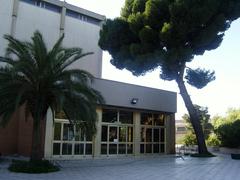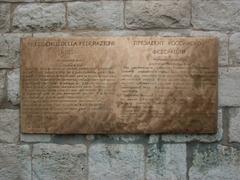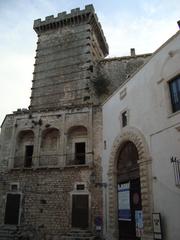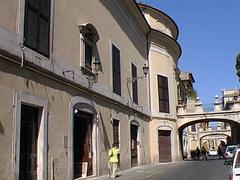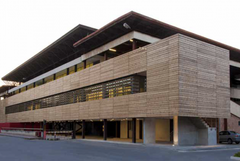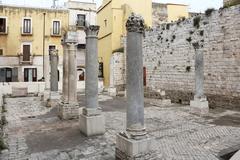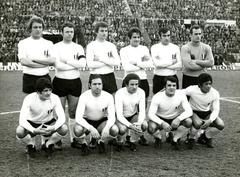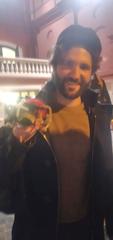Castello Normanno-Svevo Bari, Italy: Visiting Hours, Tickets, and Historical Site Guide
Date: 04/07/2025
Introduction
Located in the heart of Bari’s historic old town, the Castello Normanno-Svevo is a remarkable castle that encapsulates centuries of Mediterranean history and architectural evolution. Once a formidable defensive outpost and later a royal residence, the castle today stands as a cultural hub and museum, drawing visitors from around the world. Whether you are a history enthusiast, architecture lover, or cultural traveler, this guide provides a comprehensive overview—covering history, practical details on visiting hours and tickets, accessibility, guided tours, and nearby attractions.
For the latest updates on visiting times, ticket prices, and special events, always consult official resources before your trip (World City Trail, Italia.it, AssociazioneH1.it).
Historical Overview
Early Origins and Strategic Role
The site’s importance predates the current structure, with Byzantine-era fortifications guarding Bari’s vital harbor and trade routes. Control of this port city meant control over exchanges between East and West, making the location a prize for successive empires (World City Trail).
Norman Beginnings (12th Century)
Following the Norman conquest of southern Italy, Roger II of Sicily commissioned the castle’s construction around 1132. Merging earlier Byzantine elements, the Normans reinforced Bari’s defenses, establishing the castle as both a symbol of authority and an administrative center (Italia.it, italyscapes.com).
Destruction and Swabian Reconstruction
In 1156, the original castle was largely destroyed by King William I of Sicily. The ruins remained until Frederick II, Holy Roman Emperor, rebuilt and expanded the castle in 1233, introducing Swabian features such as the main tower, curtain walls, and moat, and establishing the fortress as a symbol of imperial might (Italia.it, nomads-travel-guide.com).
Angevin, Aragonese, and Renaissance Transformations
Under Angevin and Aragonese rule, the castle was remodeled to adapt to advances in military technology, notably artillery. Renaissance features such as sloping bastions, a wider moat, and decorative elements were added by Isabella of Aragon and her daughter Bona Sforza. The castle thus became both a stronghold and a refined court (Italia.it, italyscapes.com).
Sforza and Bourbon Eras
Eventually, the castle became the residence of Bona Sforza, then was used as a prison and barracks under the Bourbons, falling into neglect by the 19th century (Italia.it).
Restoration and Modern Role
Restoration began in the 20th century. Since 2017, the castle has served as a museum and cultural center, hosting exhibitions and events (World City Trail).
Practical Visitor Information
Visiting Hours
- Open: Daily (closed Tuesdays)
- Hours: 9:00 AM – 7:00 PM (last entry at 6:00 PM)
- Note: Hours may vary on holidays or during events; confirm via official site.
Ticket Prices (as of July 2025)
- Standard: €6.00
- Reduced: €2.00 (eligibility must be verified)
- Special Exhibitions: €9.00 (full), €3.50 (reduced)
- Free Admission: Children under a certain age and select categories (check official details)
- Purchase: On-site; pre-booking is advisable during peak periods
Accessibility
Much of the ground floor, including courtyards and exhibition halls, is wheelchair accessible. However, some historic areas (towers, upper levels) involve stairs or uneven surfaces. Staff can assist with visitor needs.
Guided Tours and Events
- Guided Tours: Offered in Italian and sometimes English; advance booking for groups is recommended.
- Audio Guides: Available for self-guided visits.
- Special Events: The castle regularly hosts exhibitions, concerts, and medieval reenactments. Check the event calendar for details.
Architectural Highlights
- Moat and Bastions: Renaissance additions for artillery defense, visible from the exterior (nomads-travel-guide.com).
- Norman and Swabian Features: Massive stone walls, central keep, and geometric layout.
- Aragonese Courtyard and Double Staircase: Reflect the castle’s transformation into a refined residence (Italia.it).
- Torre dei Minorenni: Former juvenile prison, now part of museum exhibits.
- Sala Federico II: Main hall dedicated to Frederick II, featuring interpretive panels and temporary exhibitions.
Legends and Cultural Legacy
A notable legend recounts a meeting between Frederick II and Saint Francis of Assisi at the castle, underscoring its place in local lore (nomads-travel-guide.com, wikipedia). Today, the castle is a symbol of Bari’s resilience and a vibrant venue for cultural events.
What to Expect During Your Visit
- Duration: 1 hour for a standard visit; add 30 minutes for in-depth exploration of Sala Federico II.
- Photography: Permitted, but flash and tripods may be restricted in some areas.
- Facilities: Restrooms, gift shop, exhibition spaces.
- Visitor Flow: Organized in time slots for special exhibitions; Sala Federico II accommodates up to 25 people at a time.
Nearby Attractions
- Basilica di San Nicola
- Cattedrale di San Sabino
- Bari Vecchia (Old Town)
- Lungomare Nazario Sauro (Seaside Promenade)
All are within walking distance, making Castello Normanno-Svevo an excellent starting point for exploring Bari’s historical core.
Visitor Tips
- Best Times: Spring and autumn for mild weather and fewer crowds. Early morning or late afternoon for a quieter experience.
- Footwear: Wear comfortable shoes due to uneven stone floors and stairs.
- Hydration: Bring water, especially in warmer months.
- Booking: Recommended for groups and during peak travel periods.
- Families: Supervise children, as some areas have steep stairs and high walls.
Health & Safety
- COVID-19 Measures: Mask usage may be required indoors. Check current regulations.
- Accessibility: Some areas may be challenging for those with limited mobility; inquire ahead for support.
Frequently Asked Questions (FAQ)
Q: Where is Castello Normanno-Svevo located?
A: Piazza Federico II di Svevia, close to Bari Vecchia and major landmarks.
Q: What are the opening hours?
A: Open daily except Tuesday, 9:00 AM – 7:00 PM (last entry 6:00 PM). Check for seasonal changes (AssociazioneH1).
Q: Can I buy tickets online?
A: Primarily sold on-site, but advance booking is recommended during busy periods.
Q: Is the castle accessible for wheelchairs?
A: Ground-floor areas are accessible; upper levels may have limited access.
Q: Are guided tours available in English?
A: Sometimes—check in advance or with local tourism offices.
Q: Is photography allowed?
A: Yes, but restrictions may apply in certain exhibition spaces.
Plan Your Visit and Stay Updated
For the most current information on Castello Normanno-Svevo visiting hours, ticket prices, and events, consult the official website or the Comune di Bari tourism page.
Enhance your experience:
Download the Audiala app for audio guides, event updates, and exclusive content about Bari’s historical sites.
Further Exploration
Extend your journey by visiting nearby Bari historical sites, including the Basilica di San Nicola, Cattedrale di San Sabino, and the atmospheric streets of Bari Vecchia. For dining and accommodation, options abound within walking distance of the castle (Trip.com).
Summary
Castello Normanno-Svevo invites visitors on a journey through centuries of history, architecture, and culture. Explore its Norman foundations, Swabian innovations, and Renaissance flourishes, and experience Bari’s vibrant heritage firsthand. Plan ahead for a seamless visit, and enjoy one of Italy’s most evocative historical landmarks.
References & Further Reading
- Castello Normanno-Svevo in Bari: Your Complete Guide (World City Trail)
- Castello Normanno-Svevo – Italia.it
- Castello Normanno-Svevo di Bari: Visiting Hours and Tickets (AssociazioneH1)
- Castello Normanno-Svevo: Nomads Travel Guide
- Castello Normanno-Svevo on CastlePedia
- Culture Activities – Things to Do in Bari
- TripHobo – Castello Normanno-Svevo
